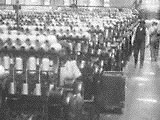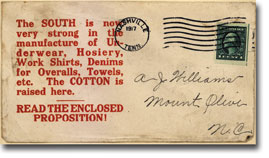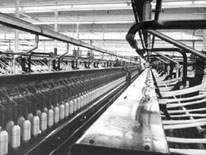North
Carolina
Business
History
With the creation of the first cotton textile mill around 1815 by Michael Schenck in Lincoln County, North Carolina began a long process towards building its manufacturing industries. By 1900, the American textile industry was well on its way to moving to the Carolinas from New England.





But free trade regulations and fierce price competition from global developing countries triggered a steady relocation of the textile industry from the Carolinas to overseas production as the 21st Century began.
Industry Development
In 1810, Tench Coxe prepared the first national assessment of manufacturing in the U.S. At that time, North Carolina was producing more textile products by hand, than was Massachusetts with its emerging factory system. (Statement of Arts and Manufactures in the United States, 1810: N. C., $2,989,140; Mass., $2,219,279.)
But North Carolina textile manufacturing grew slowly and Massachusetts efforts proliferated.
Schenck's first mill was on a small stream, McDaniel's Springs in Lincoln County just east of Lincolnton. It was damaged by 1816. He and partner Absolom Warlick contracted with Michael Beam to built new spinning machinery in April 1816 for implementation in a new mill on that stream before the end of 1817. Around 1818, Schenck decided to move the entire mill operation to the South Fork of the Catawba River (south of Lincolnton) which offered a more consistent water supply. He built another mill in 1819 with partners, John Hoke and James Bivings, which operated until 1863.
An 1822 report on textile manufacturing warned: "our citizens must turn a portion of their labours and enterprise into other channels of industry (other than agriculture and extractive efforts); otherwise, poverty and ruin will fall on every class of our community."
Textile mills spread throughout the Piedmont region, such as the Spray mills and industrial complex first started in 1839.
There were about 45 textile mills in operation by 1860 -- 39 cotton and 7 woolen mills, These antebellum textile mills were small water-powered operations. There were a substantial number destroyed during the war, especially in the last 90 days of the conflict. However following the war, many were restarted by pioneering textile families on the same sites.
Textiles would rebound leading to the First Cotton Mill Campaign during Reconstruction. By 1870, 113 textile mills were operating in the state, employing 3,053 workers, with $2,237,200 in capital and $2,923,725 in products. That would grow to (insert figures; until NC leads the country in 1923.
In 1899, North Carolina had 177 textile mills with 30,273 workers and 1.1 million spindles - ranked behind the nation's leader Massachusetts, Rhode Island, South Carolina and New Hampshire. The state produced $28.4 million in textile products, slightly behind South Carolina with $29.7 million and far behind Massachusetts with $110.5 million.

That order would all change by 1925. In 1923, there were 351 mills in North Carolina, employing 81,041 workers producing $326.5 million in goods. Only Massachusetts would edge the Old North State.
The growing textile industry during 1930 - 1990 helped North Carolina's economic development. But controversy hit the mills in the early years of the century with protests over child labor leading to new U.S. and state laws. In addition, labor unrest and attempts at unionization marked the business with periodic turmoil.
With unionization making in-roads during the 1980s and 1990s, the textile industry also faced stiff price competition from overseas producers.
Just as the industry had moved South during the 1880 - 1935 period to take advantage of lower production and wage costs, so too did the industry in the 1990s begin to shift production into other countries.
The industry has faced numerous bankruptcy reorganizations during the past decade. There are still North Carolina firms that have carved and maintained a world-leading textile niche. But textile industry employment continues to decline.
Click
for 4:11 min QT movie of
1924 Cotton Mill Operation
from cotton bales to spun yarn
(18Meg) Download and
buffering
these files may take a
a moment (you need to allow a
popup wndow)

NC Textile Mills pre-1860
click above to link to this page
NC Textile Mills
(listing incomplete,
under construction)
1820
2 cotton mills
1830 3 cotton
mills
1840
25 cotton
mills
1850 28
cotton mills
1860 39 cotton mills
1870 33 cotton mills
1880
cotton mills
1890
cotton mills
1900 177 cotton mills
40 wool mills
1910
cotton mills
1920
cotton mills
1930
cotton mills
1940
cotton mills
1950
cotton mills
1960
cotton mills
1970
cotton mills
1980
cotton mills
1990 cotton mills
2000
cotton mills
NC Laureates (Textiles)
Charles A.
Cannon
Alan T. Dickson
Rush S. Dickson
R. Stuart
Dickson
Luther H. Hodges
W. Duke Kimbrell
J. Spencer
Love
James H.
Millis Sr.
Edwin A. Morris
Sr.
Charles F.
Myers, Jr.
Claude S. Ramsey
Jr.
Industries Laureates Contact
Us Home
2006 Copyright. CommunicationSolutions/ISI for web site and content.